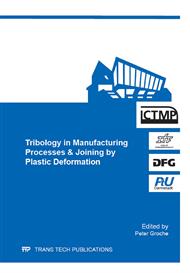p.453
p.461
p.471
p.481
p.489
p.500
p.510
p.521
p.536
Magnetic Pulse Welding by Electromagnetic Compression: Determination of the Impact Velocity
Abstract:
The implementation of multi-material concepts and the manufacturing of modern lightweight structures, for example in automotive engineering, require appropriate joining technologies. The ability to join dissimilar materials without additional mechanical elements, chemical binders, or adverse influences of heat on the joining partners is key in reaching the desired weight reduction in engineering structures. The Magnetic Pulse Welding (MPW) process meets these demands, making it a viable alternative to conventional thermal welding and mechanical joining processes. The present paper focuses on the analytical determination of the impact velocity as one of the key parameters of MPW processes. On the basis of experimentally recorded data concerning the course of the discharge current and geometrical parameters of the welding setup, the respective velocity is determined. A comparison with measurement data gained by Photon Doppler Velocimetry is performed.
Info:
Periodical:
Pages:
489-499
Citation:
Online since:
June 2014
Price:
Сopyright:
© 2014 Trans Tech Publications Ltd. All Rights Reserved
Share:
Citation:


